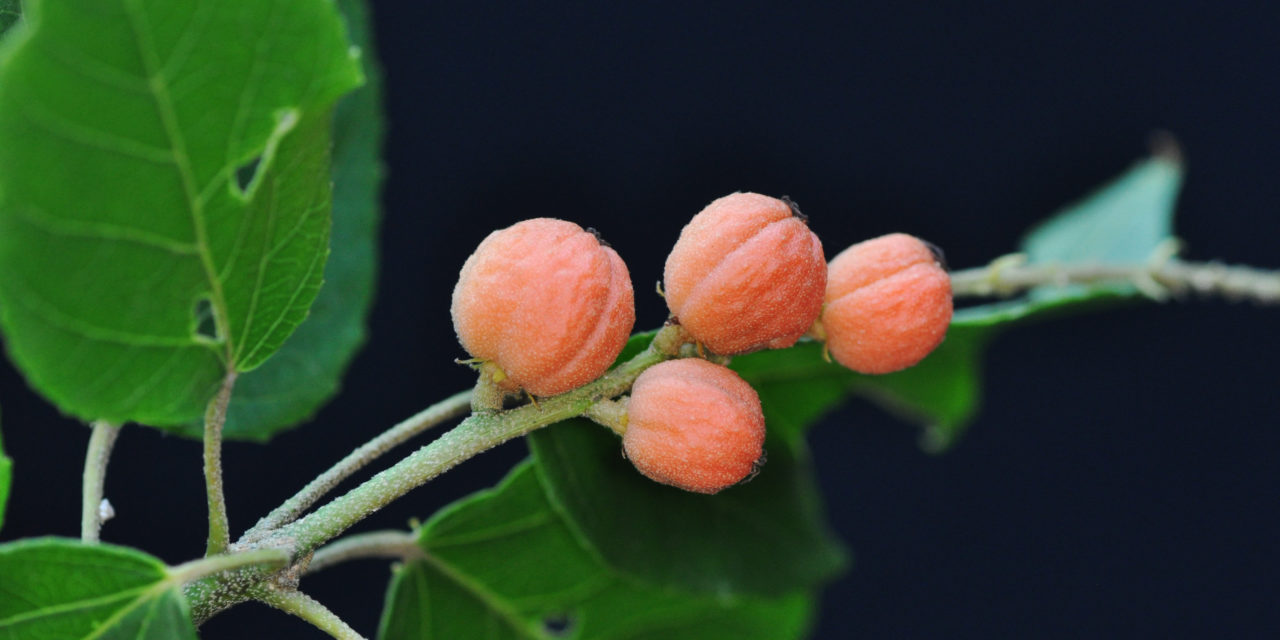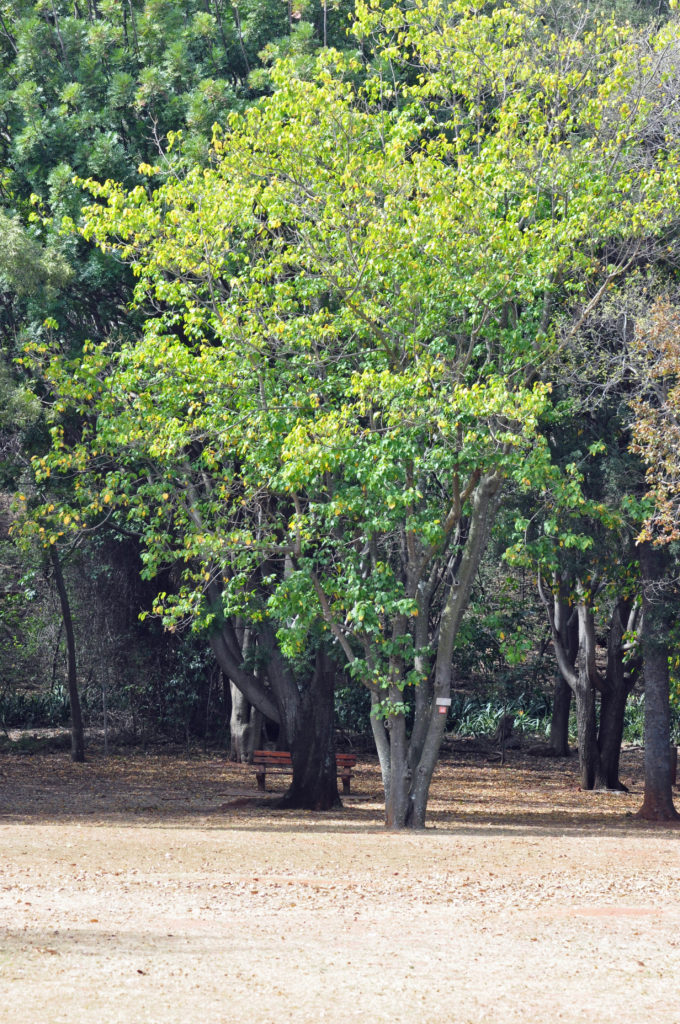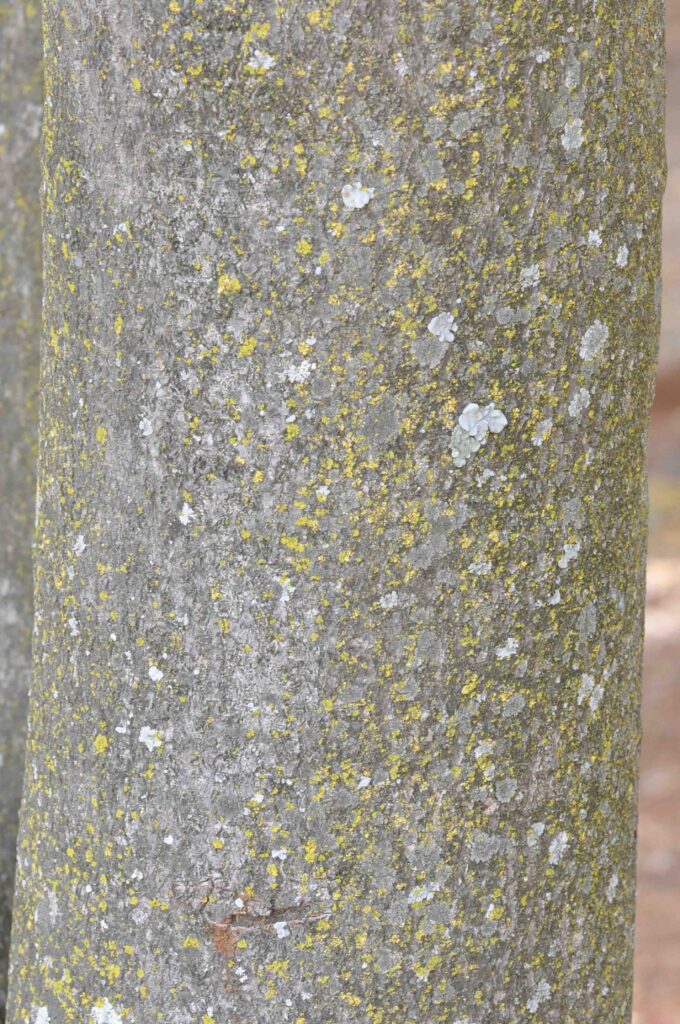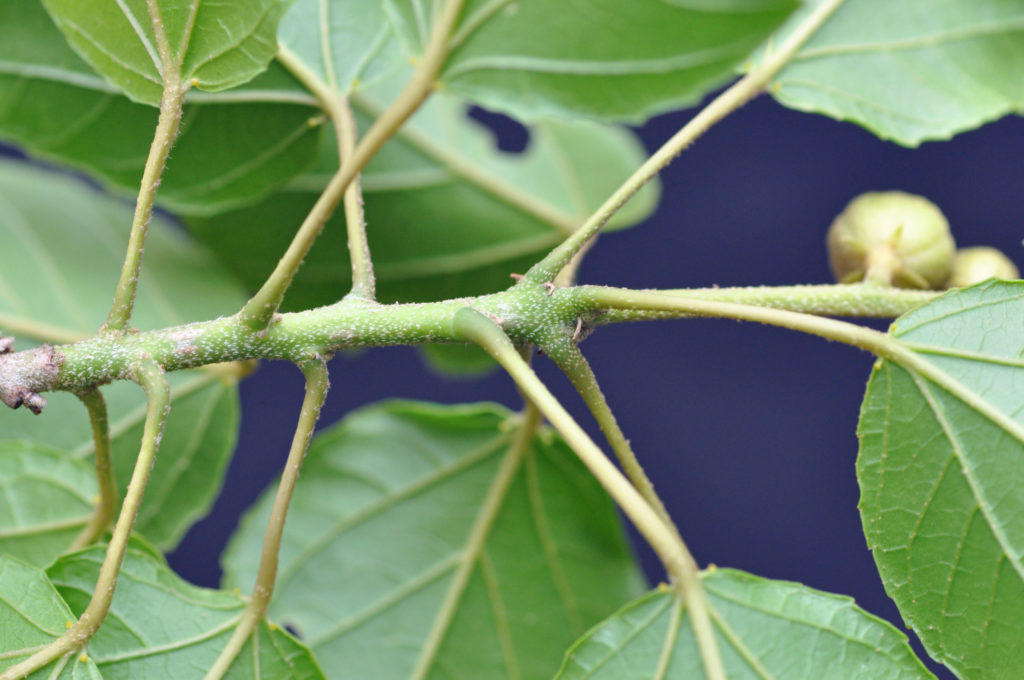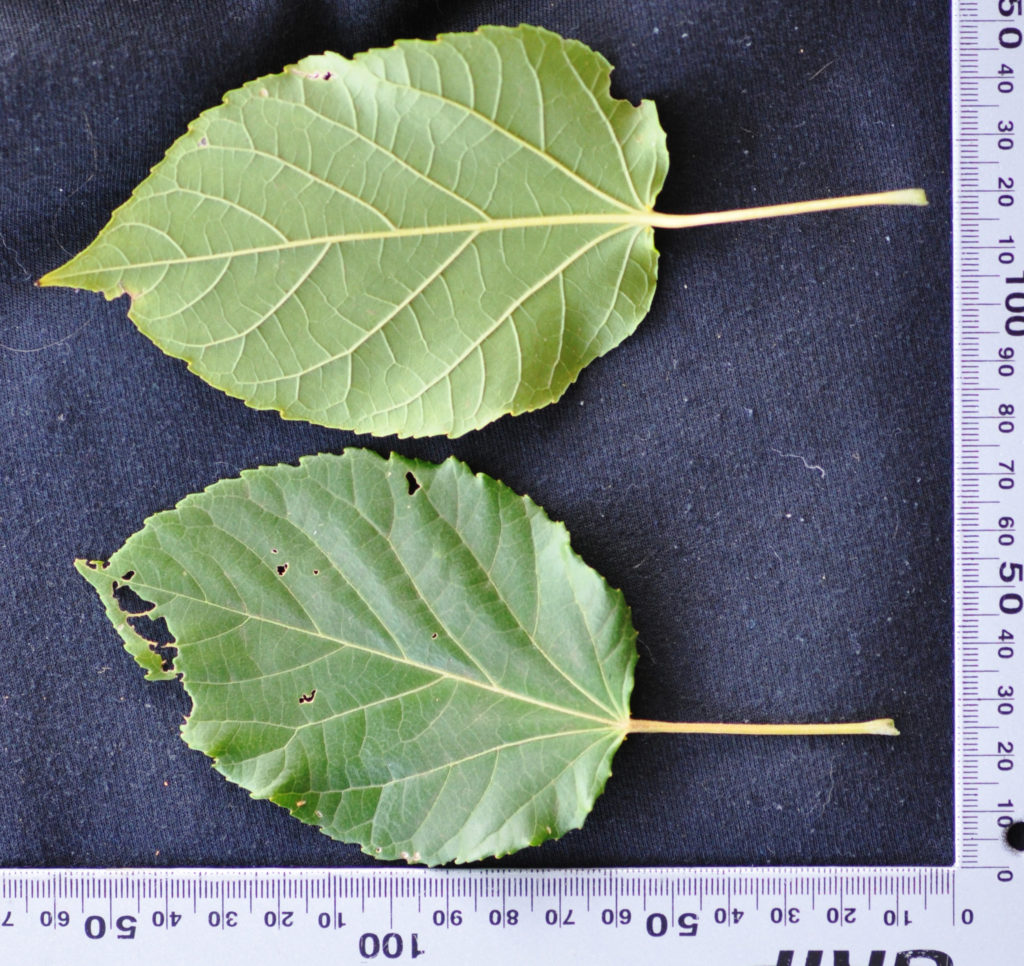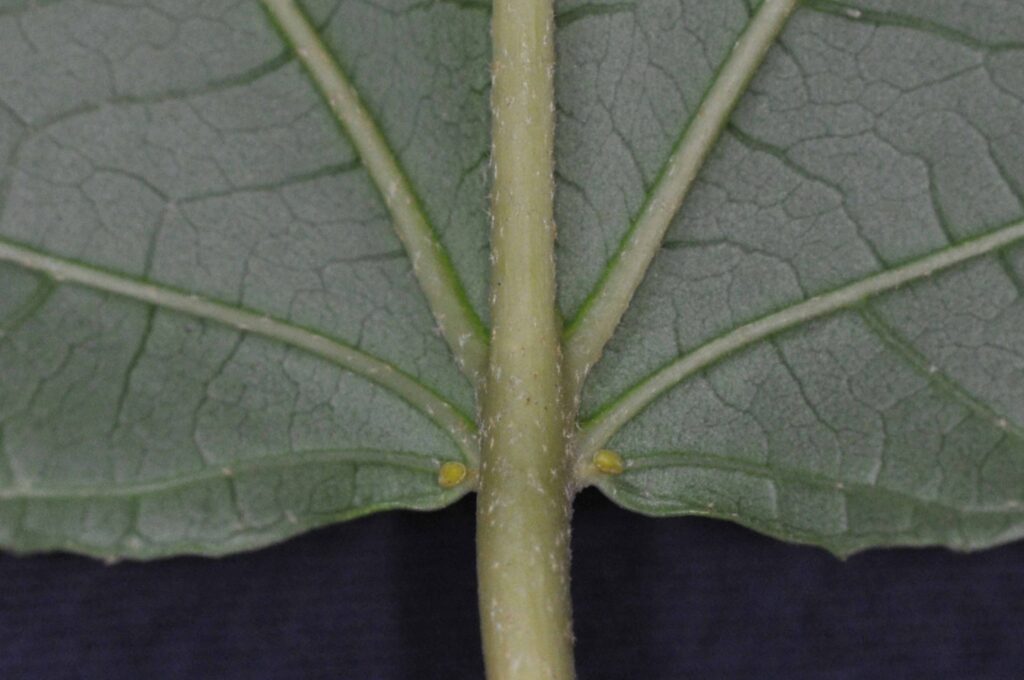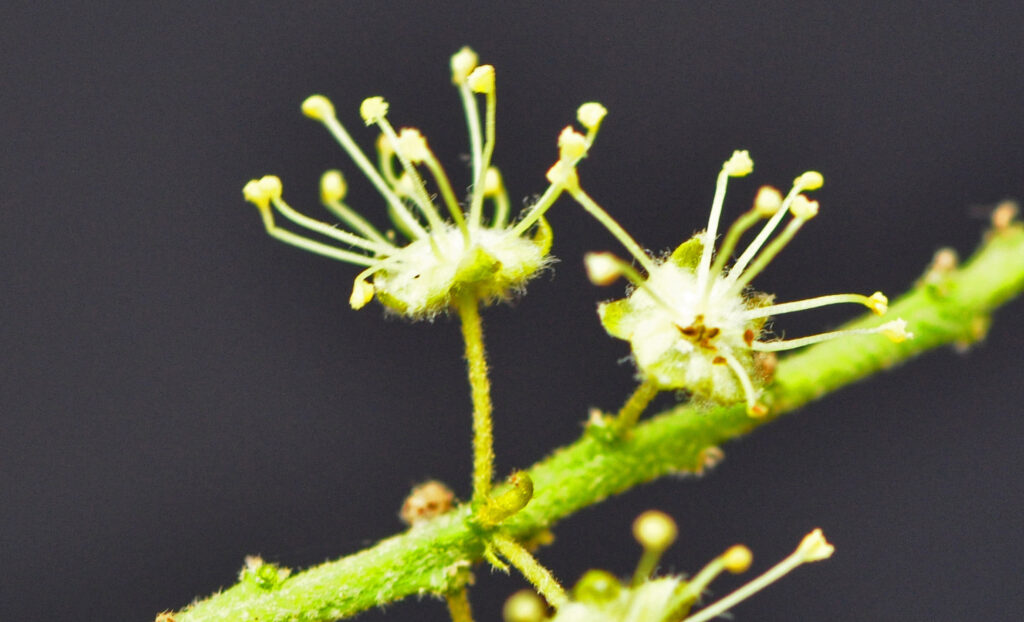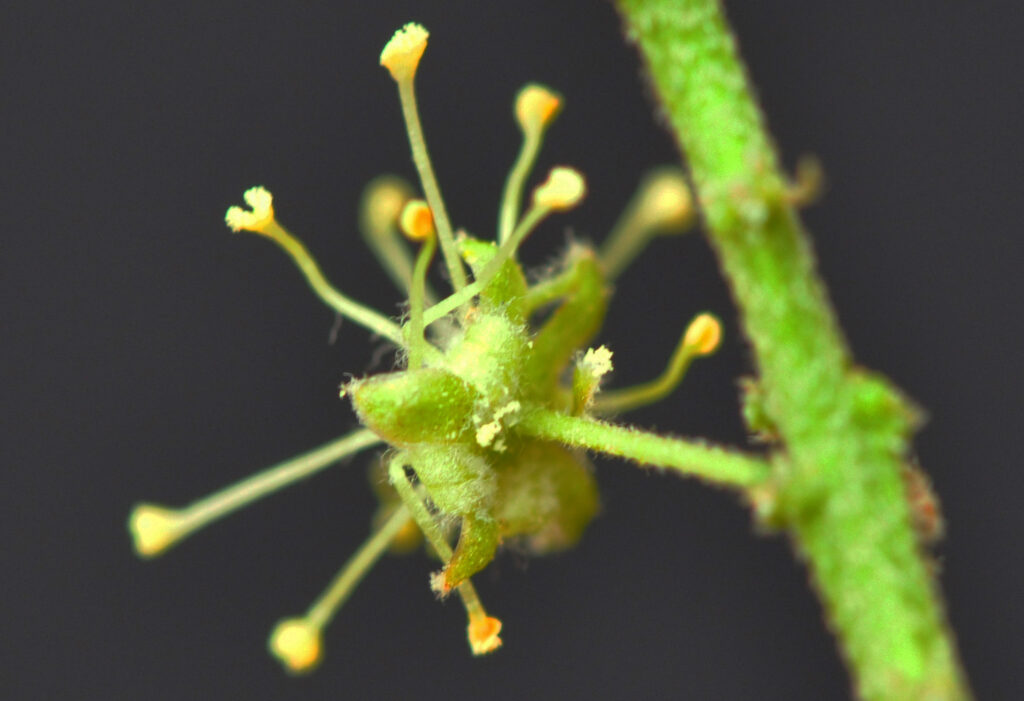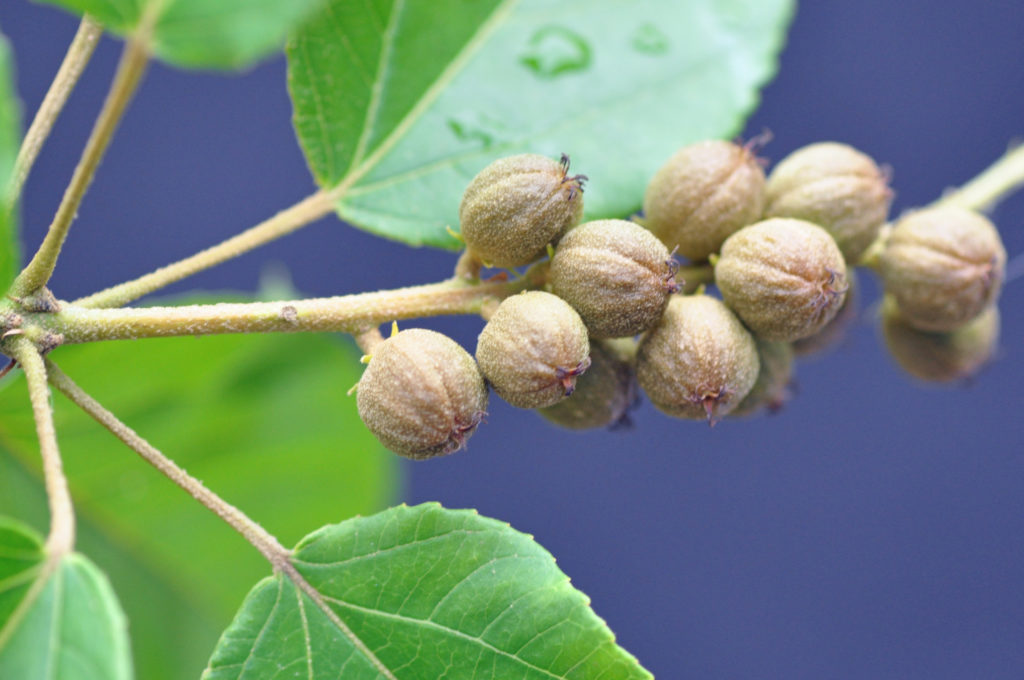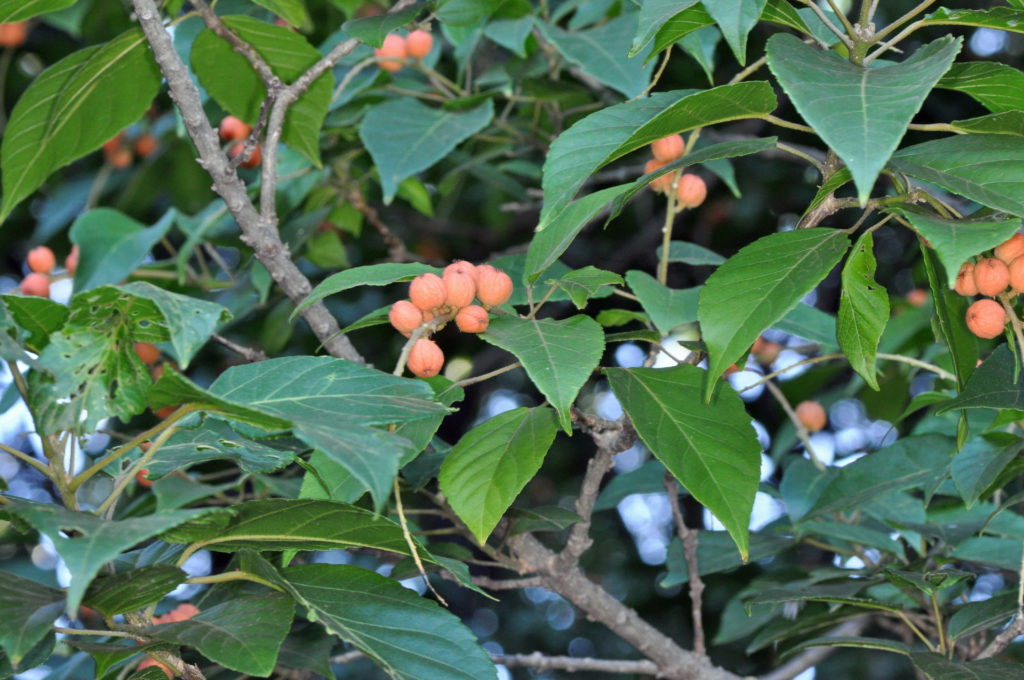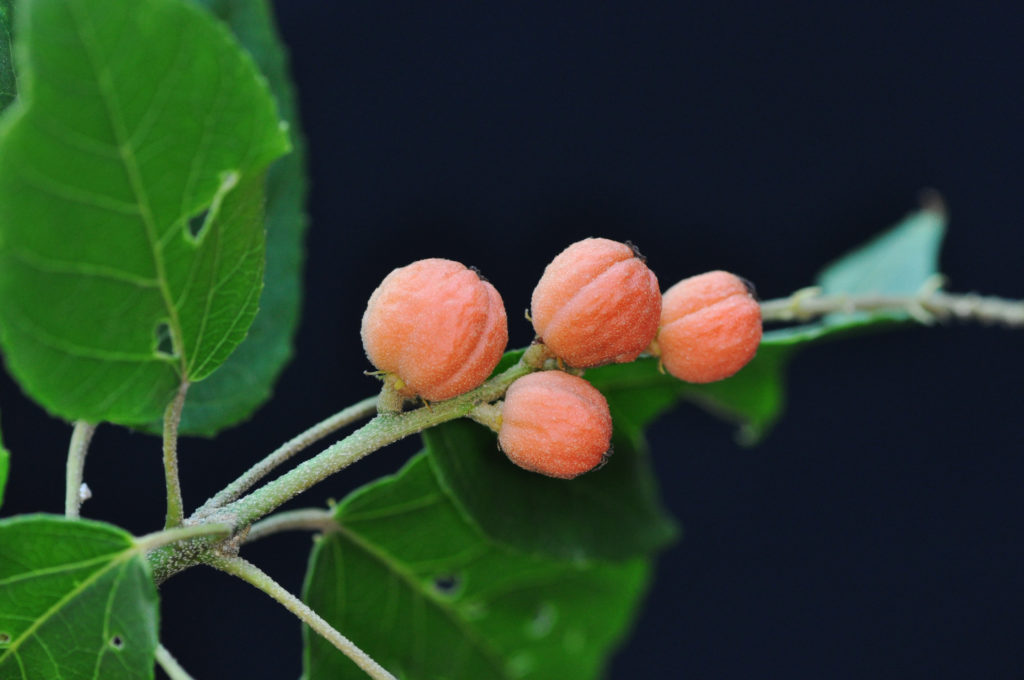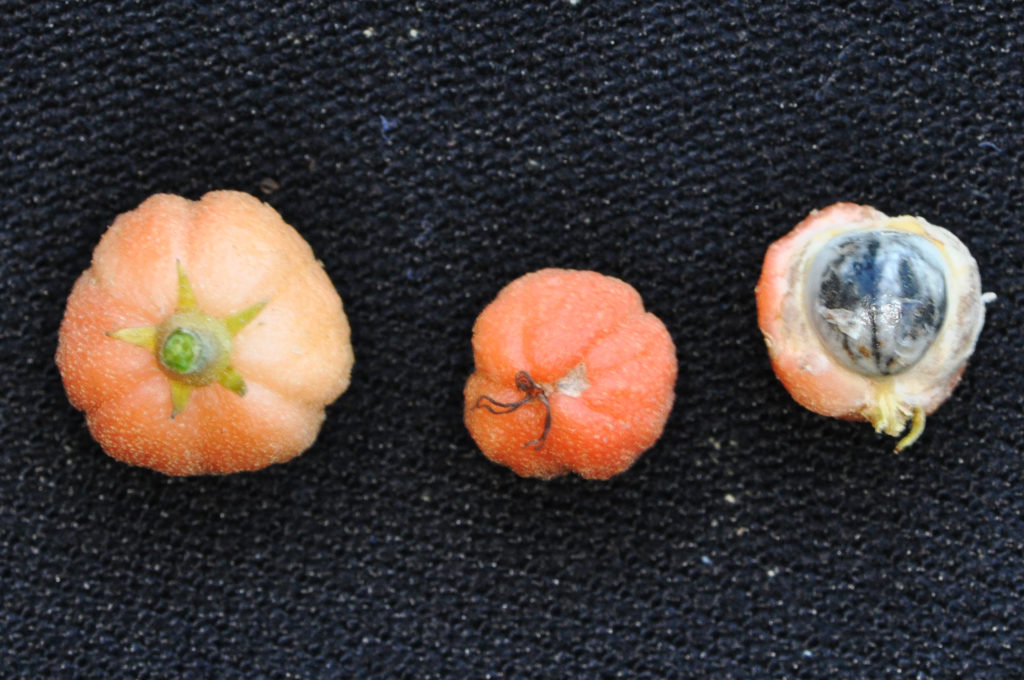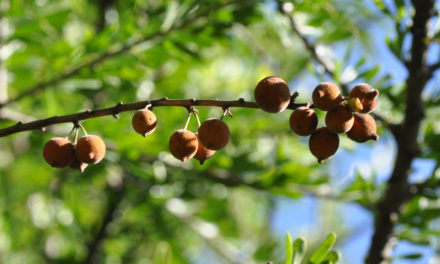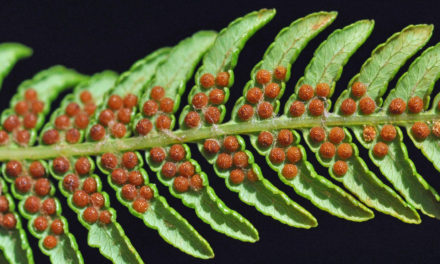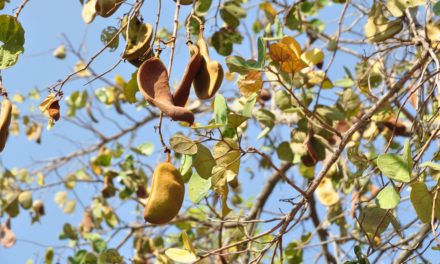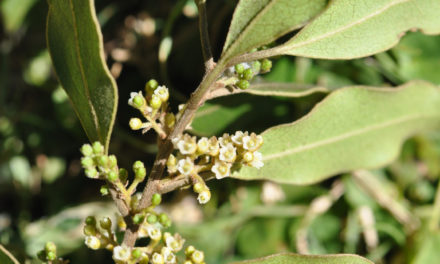General Info – summary
This monoecious Tree, with watery latex and smooth bark, is up to 12m+ high and 1m wide. Simple, ovate and alternate Leaves have up to 5 side veins. The leaf base has a midrib with 2-3 pairs of veins and 2 stalked glands. The small, unisexual, regular and 5-merous Flowers are in racemes with fewer female flowers at the base. Fruit is a 3-lobed capsule with a persistent calyx and up to 3 hard, carunculate seeds.
Description
Croton sylvaticus
Previous Names: Nil.
SA Tree No. 330.
Common names: (Afr) Boskoorsbessie, Bos-koorsbessie, Koorsboom, Wilde Moerbei, Without. (Eng) Fever Tree, Forest Croton, Forest Fever-berry, Woodland Croton. (isiXhosa) Umakhwakane, Umegwaqane, Umfeze (spittle-bug), Umgqwagane, Umgqwaganisa, Umgwaqanisa. (isiZulu) Amahlabakufeni, Indumbahlozi, Isikhumaphuphu, Ugebeleweni, Ugibeleweni, Umahlabekufeni, Umhlalajuba, Umhloshazana, Umhloshozane, Umhlakele, Uminya, Umzilanyoni. (Northern Sotho), Moêma, Moêma-tswetsi. (siSwati) Nyakene. (Tshivenda) Muima-vanda, Mula- thoho.
Family Euphorbiaceae (Spurge family) e.g., the well-known exotic poinsettia – Euphorbia pulcherrima) with its normally bright red colour due to bracts not perianth parts. The plants may be trees shrubs or herbs. Trees up to 15m high and the trunk may reach 46cm wide. Spines are paired or absent. Latex/watery sap present. Trees may be monoecious (male & female on the same plant) or dioecious (male and female parts on separate plants). Genera on this site include Croton, Euphorbia and Spirostachys.
Leaves are absent or reduced, may fall early and may be largish. When present most leaves are simple e.g., Spirostachus. When compound the leaves are always palmate (hand-like: compound with leaflets arising from one point). Leaf shape varies from ovate to lanceolate. Leaf arrangement is in spirals, opposite or alternate. Stipules may be spinescent e.g., Euphorbia sp. or may be lost early e.g., Spirostachus. At the leaf base, the veins are single (midrib) or are 3-5 veined e.g., Macaranga. Domatia may occur e.g., in Alchornea. Leaves may smell of almonds if crushed e.g., Croton sp. When leaves are present margins are usually irregularly serrated. Petioles may be swollen at 1 or both ends. 2 glands often occur at base of leaves e.g., Spirostachys. In some Euphorbiaceae plants CAM (Crassulacean acid metabolism) photosynthesis can occur.
The unisexual Flowers are Actinomorphic (Regular, symmetrical). They may lack a calyx or a perianth (calyx and corolla). Inflorescences develop terminally or in leaf axils. Flowers may develop in 1. racemes (a simple, unbranched, indeterminate inflorescence with pedicellate – stalked flowers along the axis that open in succession towards the apex) e.g., Macaranga & Croton. 2. cyathia (cup-shaped Euphorbia inflorescence that appears as a single flower but is, in fact, a collection of reduced flowers. (They usually have 5 joined bracts outside: up to 10 brightly coloured nectar glands which may have petal-like appendages or brightly coloured bracts followed by 5 much reduced male flowers at the base of each bracteole. In the centre is a much-reduced female flower). 3. spikes (simple indeterminate inflorescence with sessile flowers on a single unbranched axis opening in succession towards the apex e.g., Spirostachys). 4. panicles (determinate or indeterminate, much branched inflorescence with stalked flowers. The branches of a panicle are often racemes. Petals are absent e.g., Macaranga. Male flowers may lack an ovary and have 1-8 or many e.g., Croton, exerted stamens. Fewer Female flowers have a superior ovary with 1 ovule per 1-to many locules and each locule has 1 or 2 ovules. 3 styles may be present. Most flowers are insect pollinated. Fruit may occur in long racemes or small lobed, dehiscent or indehiscent capsules. Seeds may have a caruncle (a fleshy structure attached to the seed) and may be poisonous.
Name derivation: Croton – resembling ticks – referring to the shape of the fruit or seeds. sylvaticus – the forest loving, woodland Croton. There are about 11 species of the genus Croton in South Africa.
Conservation: National Status: L C. Least Concern. Assessed: 2008 (V.L. Williams, D. Raimondo, N.R. Crouch, A.B. Cunningham, C.R. Scott-Shaw, M. Lötter and A.M. Ngwenya).
Tree
This shrub or medium sized Tree (usually up to 12m but may reach 40m high – photo 629) with its watery latex, has a straight Trunk, which may reach 1m wide. The pale to dark grey Bark (photo 628) is smooth with prominent leaf scars – when young. A pink colour shows through the lengthwise-striated older bark, which become rough with age. The light brown Branches are smooth and grooved. Twigs may have short rusty coloured hair. Pink or grey Lichen (specialised fungi cultivate algae partners that manufacture food for them by photosynthesis – photo 628) may be present.
- 629 2016.08.23 Pretoria NBG. Photo: David Becking.
- 628 2016.08.23 Pretoria NBG. Photo: David Becking
Leaves
This tree may be deciduous, and Leaves are simple (have a single blade, which may have incisions that are not deep enough to divide the leaf into leaflets). They are usually ovate (egg-shaped and widest near the base), alternately arranged (photo 644) and up to 21 x 14cm. The slightly shiny Blade is darkish green above, lighter below but not significantly bicoloured (photo 649). Young leaves may have stellate hairs on both sides. Mature leaves become smooth and hairless with 4-5 distinct lateral Veins arising from the midrib (photo 649). Apart from the midrib, up to 3 additional pairs of veins arise from the leaf base (photo 300R). These yellowish veins protrude and are more visible below. The Apex (photo 649) may taper abruptly or slightly and may end in a drip-tip. The flattish Base is rounded to slightly cordate (heart shaped – photo 300R). There are 2 small protruding knob-like glands at the base of the Midrib – best seen, with the aid of a hand lens, on the lower surface (photo 300R). The Margin is irregularly serrated (photo 649) with glandular teeth. In this photo the up to 8cm long, thin Petiole (leaf stalk) is visible. Thin Stipules (basal appendages of the petiole) are present but fall early (photo 644). Crushed leaves smell of almonds.
- 644 2017.01.31 Pretoria NBG. Photo: David Becking.
- 649 2016.08.23 Pretoria NBG. Photo: David Becking.
- 300R 2007/08/03 Pretoria NBG. Photo: David Becking.
Flowers
The tree is monoecious (having both male and female reproductive organs on the same plant) and the very small, pale greenish-yellow Flowers are contained in Racemes (a simple elongated inflorescence with stalked flowers). A thin, hairy and long Pedicel (stalk of a single flower – photo 138) supports each flower. The male and female flowers are unisexual and separate. A Disc (a more or less fleshy or elevated development of the receptacle) is present. All flowers lack petals and the 5-merous calyx (photo 13 under Fruit) remains smaller in the male flowers. The Male flowers occur alone or are most numerous towards the end of each inflorescence. The many Stamens have Filaments that are inflexed in the bud but become exserted in the mature flower (photo 138). There is no Ovary present. The fewer Female flowers may be located at the base of each inflorescence. Here the superior Ovary has a single Ovule in each locule. Male and female flowers do not open at the same time. This helps support cross-fertilization. (Sep-Jan).
- 138 2017.12.26 Pretoria NBG. Photo: David Becking.
- 141 2017.12.26 Pretoria NBG. Photo: David Becking.
Fruit
This almost spherical, initially light green Fruit is a 3-lobed Capsule (a dry fruit resulting from the maturing of a compound ovary, which usually opens at maturity by one or more lines of dehiscence). It is about 1,5cm wide. As they mature, the long racemes of fruit become a brilliant orange colour and strongly contrasts with the leaves (photo 10). The persistent 5-lobed Calyx is somewhat accrescent (the calyx continues to grow with the fruit – photo 13). The initially slightly hairy fruit is perched on a small stalk (photo 10). The conspicuous, orange mature fruit contains 2 or 3 smooth poisonous (to us) Seeds (photo 13). Some birds and other animals eat them. Each seed has a hard Testa (seed coat) and abundant fleshy albumen (starchy or other nutritive material surrounding the embryo) is present. The seeds are carunculate (have a fleshy outgrowth from a seed – near the micropyle). The micropyle is a small opening in the surface of an ovule, through which the pollen tube penetrates. (Oct-Mar).
- 643 2017.01.31 Pretoria NBG. Photo: David Becking.
- 12 2017.03.21 Pretoria NBG. Photo: David Becking.
- 10 2017.03.21 Pretoria NBG. Photo: David Becking.
- 13 2017.03.21 Pretoria NBG. Photo: David Becking.
Distribution & Ecology
These plants occur naturally in forests (often coastal) and from Port St John’s in the Eastern Cape, KwaZulu-Natal, Limpopo and Mpumalanga. In parts of the Kruger NP, this plant may remain a shrub. Beyond South Africa, the trees occur in Swaziland, Mozambique, Zimbabwe and northwards. These plants occur in the forest or forest margins and stream banks up to an altitude of 1 700m. In dry times, leaves may turn yellow and fall. The few Birds that are attracted to the fallen poisonous Fruit include Forest Weavers, Green Pigeons, Cinnamon Doves, Red-eyed Turtle Doves and Hornbills. Blue duiker and bushpigs also consume fallen fruit. This is a “rain tree” caused by spittlebugs (they are froghoppers whose plant-sucking nymphs encase themselves in foam in springtime). The foam is a form of protection but some lands on the ground as a liquid). Green-veined Charaxes (Charaxes candiope) Butterfly larvae with large green bodies and horny heads, feed on these leaves and on those of other members of the genus Croton. Beetles and some moth species also feed in the leaves.
Ethnobotany
In Southern Mozambique, the powdered Bark is used for tanning and as a fish poison. The easily worked Wood is light in colour and may contain dark streaks. Wood burns, even when green. Young plants need protection from frost. Local medicine makes use of plant parts. In parts of Mozambique and Zimbabwe, the bark is used as a fish poison. This attractive shade tree, grows well from seeds and makes an impressive show in gardens.
References
Boon, R. 2010. Pooley’s Trees of eastern South Africa. Flora and Fauna Publications Trust, Durban.
Burrows, J.E., Burrows, S.M., Lotter, M.C. & Schmidt, E. 2018. Trees and Shrubs Mozambique. Publishing Print Matters (Pty) Ltd. Noordhoek, Cape Town.
Coates Palgrave, M. 2002. Keith Coates Palgrave Trees of Southern Africa, edn 3. Struik, Cape Town.
Ginn, P.J. McIlleron, W.G. Milstein, S. 1989. The Complete Book of Southern African Birds. Struik Publishers (PTY) LTD. Third impression 1991
Lawrence, G. H. M, 1951. Taxonomy of Vascular Plants. The Macmillan Company, New York. Tenth Printing 1965.
Palmer, E. & Pitman, N. 1972. Trees of southern Africa, Balkema, Amsterdam, Cape Town.
Schmidt, S. Lotter, M. & McCleland, W. 2002. Trees and Shrubs of Mpumalanga and the Kruger National Park. Jacana, Johannesburg.
van Wyk, B. & van Wyk, P. 1997 Field guide to Trees of Southern Africa. Struik, Cape Town.
Williams, V.L., Raimondo, D., Crouch, N.R., Cunningham, A.B., Scott-Shaw, C.R., Lötter, M. & Ngwenya, A.M. 2008. Croton sylvaticus Hochst. National Assessment: Red List of South African Plants version 2020.1. Accessed on 2023/01/25.
http://pza.sanbi.org/croton-sylvaticus
https://en.wikipedia.org/wiki/Charaxes_candiope
http://www.plantbook.co.za/croton-sylvaticus/
http://www.worldagroforestry.org/treedb/AFTPDFS/Croton_sylvaticus.PDF
https://www.ispotnature.org/species-dictionaries/sanbi/Croton%20sylvaticus
http://www.zimbabweflora.co.zw/speciesdata/species.php?species_id=134820

